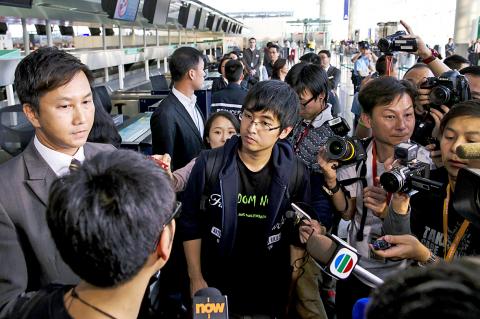Hong Kong student leaders of pro-democracy protests were blocked from flying to Beijing as they sought to meet with Chinese leaders to press their case for open elections for the territory’s chief executive in 2017.
Three members of the Hong Kong Federation of Students were told by airline personnel that they could not board because Chinese authorities canceled their so-called “home return permits,” federation Secretary-General Alex Chow told reporters at Hong Kong International Airport yesterday, in comments broadcast live on Cable TV Hong Kong.
The students had planned to seek talks with Chinese officials on their own after requests to former Hong Kong chief executive Tung Chee-hwa (董建華) and Rita Fan (范徐麗泰), a Hong Kong deputy to China’s National People’s Congress, to arrange a meeting apparently went unheeded. The federation wants Beijing to reverse its decision to vet candidates for Hong Kong’s chief executive election in 2017, the group said in a statement on Facebook.

Photo: Reuters
Hong Kong Police Commissioner Andrew Tsang (曾偉雄) yesterday said that his force would help clear protest sites that have blocked main roads and disrupted the territory for more than seven weeks after a judge dismissed demonstrators’ appeals against orders to remove them.
The street occupations are illegal and protesters should not interfere when the removal of blockades begins, Tsang said in a press briefing broadcast live on Cable TV Hong Kong. He did not say when that would be.
Hong Kong High Court Chief Judge Andrew Cheung Kui-nung’s (張舉能) ruling means that bailiffs can remove obstructions at two protest sites in Mong Kok on the north side of Victoria Harbour. An injunction was also granted against protesters in Admiralty, where the city’s government headquarters are located. Under the injunctions, police are authorized to assist in the clearing and to arrest anyone who interferes.
The ruling risks reigniting violent clashes between police and protesters as government talks with student leaders are stalled. Chinese President Xi Jinping (習近平) last week expressed support for Hong Kong Chief Executive Leung Chun-ying (梁振英) while hosting the APEC summit in Beijing.
The protests were sparked by China’s decision to control the nomination process for the city’s first leadership election in 2017, issuing the biggest challenge that Hong Kong has posed for China since its resumption of sovereignty over the territory in 1997.
The protest movement that has occupied Hong Kong’s streets in main commercial districts since September is losing momentum amid dissent among its leaders and dwindling crowds. Hong Kong Chief Secretary Carrie Lam (林鄭月娥) has ruled out more talks with the students.
The Mong Kok injunctions were brought by taxi and bus drivers who said that their business has been impaired by the blockage of key roads by the students.

‘WIN-WIN’: The Philippines, and central and eastern European countries are important potential drone cooperation partners, Minister of Foreign Affairs Lin Chia-lung said Minister of Foreign Affairs Lin Chia-lung (林佳龍) in an interview published yesterday confirmed that there are joint ventures between Taiwan and Poland in the drone industry. Lin made the remark in an exclusive interview with the Chinese-language Liberty Times (the Taipei Times’ sister paper). The government-backed Taiwan Excellence Drone International Business Opportunities Alliance and the Polish Chamber of Unmanned Systems on Wednesday last week signed a memorandum of understanding in Poland to develop a “non-China” supply chain for drones and work together on key technologies. Asked if Taiwan prioritized Poland among central and eastern European countries in drone collaboration, Lin

The US government has signed defense cooperation agreements with Japan and the Philippines to boost the deterrence capabilities of countries in the first island chain, a report by the National Security Bureau (NSB) showed. The main countries on the first island chain include the two nations and Taiwan. The bureau is to present the report at a meeting of the legislature’s Foreign Affairs and National Defense Committee tomorrow. The US military has deployed Typhon missile systems to Japan’s Yamaguchi Prefecture and Zambales province in the Philippines during their joint military exercises. It has also installed NMESIS anti-ship systems in Japan’s Okinawa

The Chien Feng IV (勁蜂, Mighty Hornet) loitering munition is on track to enter flight tests next month in connection with potential adoption by Taiwanese and US armed forces, a government source said yesterday. The kamikaze drone, which boasts a range of 1,000km, debuted at the Taipei Aerospace and Defense Technology Exhibition in September, the official said on condition of anonymity. The Chungshan Institute of Science and Technology and US-based Kratos Defense jointly developed the platform by leveraging the engine and airframe of the latter’s MQM-178 Firejet target drone, they said. The uncrewed aerial vehicle is designed to utilize an artificial intelligence computer

Renewed border fighting between Thailand and Cambodia showed no signs of abating yesterday, leaving hundreds of thousands of displaced people in both countries living in strained conditions as more flooded into temporary shelters. Reporters on the Thai side of the border heard sounds of outgoing, indirect fire yesterday. About 400,000 people have been evacuated from affected areas in Thailand and about 700 schools closed while fighting was ongoing in four border provinces, said Thai Rear Admiral Surasant Kongsiri, a spokesman for the military. Cambodia evacuated more than 127,000 villagers and closed hundreds of schools, the Thai Ministry of Defense said. Thailand’s military announced that